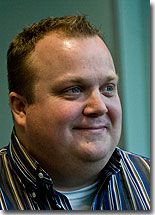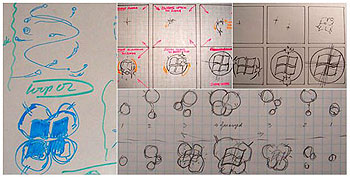Editor’s note:
This is the third story in “
Seven Behind Windows 7
,” a series featuring Microsoft employees who helped build Windows 7.
REDMOND, Wash. — Nov. 30, 2009 — When Rolf Ebeling was working on the Windows 7 startup animation, he sought inspiration all around him.

“Having only been with the company for four months and suddenly finding myself working on the first thing millions of people would see when they started up Windows 7 … was a peculiar realization to wake up to each morning,” Ebeling says.
He squinted at the way streetlights glowed in the rain. He watched the way light reflected on water. He looked at the electric zigzag of fireflies in flight. Ebeling knew the Microsoft Windows team wanted something that reflected the feeling of the new operating system—light, color, energy.
Ebeling created a 105-frame startup animation hoping to give users something beautiful and familiar during those few seconds when Windows 7 starts up. Now, every day millions watch Ebeling’s design: four swirling points of light that come together to form a pulsing Windows 7 flag.
“We never lost sight that we wanted the boot-up to be faster, but thought, ‘Well, if people are going to be there we should make it attractive and something that inspires confidence,'” said Ebeling, a senior user experience lead for the User Experience Design and Research Team for Windows, Windows Live and Internet Explorer.
Before joining Microsoft in April 2008, Ebeling was creative director for Newsweek.com in New York City. In his eight years at Newsweek, he was on call 24 hours a day during one of the most eventful decades in news history, covering everything from terrorist attacks to war to landmark elections.
A self-taught designer with a degree in English literature, Ebeling never held a software job until he came to Microsoft. Along with developing the startup animation for Windows 7, he also helped with the appearance and functionality of the calculator.
“It has been an eye-opening 18 months, as you might imagine,” he said. “It’s a lot to learn. I keep hearing that fire-hose metaphor—it felt like multiple fire hoses.”
PressPass: What was the biggest challenge or hurdle you faced working on the Windows 7 startup animation?
Ebeling: Biggest challenge? Having only been with the company for four months and suddenly finding myself working on the first thing millions of people would see when they started up Windows 7. That was a peculiar realization to wake up to each morning.
PressPass: What was a typical day like working on Windows 7?
Ebeling: Given that I was learning more about Microsoft and Windows all the time, there was certainly something different to each day. But what impressed me was the regular rhythm of the operation—the consistent attention to visual detail, the frequent communication, the thoughtfulness. Having come from the frenetic, albeit exciting, world of news-cycle-driven design, it has been a rewarding change of pace.

Sketches of the early startup animation concept. Ebeling said he looked everywhere for inspiration, including street lights in the rain, light reflecting off water, and fireflies.
PressPass: How did you get customer input about the Windows 7 startup, and how did this feedback change the design?
Ebeling: Youssef Barakat [from development], Karen Wong [from program management], myself and many others never lost sight of the obvious: the boot needed to be fast. And we thought long-term—how would this animation feel years down the line?
PressPass: Was teamwork important to this project and your feature—how so?
Ebeling: It still amazes me that I’ve never met the program manager for the calculator, Gokul Singh [who is based in Hyderabad, India], face to face. Yet despite having to bridge half a day’s time difference and thousands of miles between us, our groups struck the right balance between advanced features and designing for everyday usage. That’s teamwork.
PressPass: What do you need to do your best work?
Ebeling: Music. I have an incurable addiction to indie rock—especially flavor-of-the-moment UK bands.
PressPass: What was the most important or surprising thing you learned while working on Windows 7?
Ebeling: Partnership is essential. Establishing and maintaining trust with the people you work with—program managers, developers, testers and researchers, among others—is central to the process of shipping great product design.
PressPass: What’s the thing you’re proudest of in Windows 7?
Ebeling: The weekend after launch, I walked into a Best Buy just to stand in the crowd shopping for new PCs running Windows 7. Seeing the genuine enthusiasm in people as they tried out the new taskbar or sampled the desktop backgrounds was really satisfying. And knowing that I had the fortune of contributing a small part of someone’s new PC experience—that was great.
PressPass: Did you look forward to seeing the startup animation out in the world with the launch? How do you think people will react to it?
Ebeling: I can’t lie—seeing a few seconds of the boot animation in a snappy, fun Windows 7 commercial for a Sony touch-screen PC was really exciting. Long term, I’m hopeful those swirling lights and their glow will remain a welcome start to someone’s time on a computer.
PressPass: What’s next for you at Microsoft?
Ebeling: The next version of Windows.
PressPass: What do you do when you’re not working?
Ebeling: After hours, I have a great gig as a personal assistant for our 2 ½-year-old daughter—helping her dress dolls, adjusting tiaras. At some point, I imagine our 3-month-old daughter will want in on this as well. After more than a decade living in Manhattan, my wife and I are enjoying road trips, the trees, and the quiet of suburbia.
And when no one is paying attention, I’m hunting down import CDs in record stores or fighting for my multiplayer dignity on Xbox LIVE.




